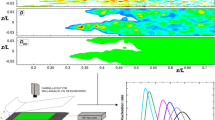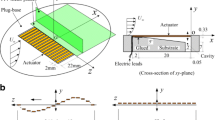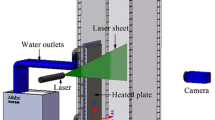Abstract
An experiment investigating the laminar–turbulent transition of a Blasius boundary-layer-like flow was set up in the laminar water channel at the Institute of Aerodynamics and Gas Dynamics, University of Stuttgart. The late stage of controlled transition with K-type breakdown was investigated with the temperature-sensitive paint (TSP) method on the flat-plate surface. Additional velocity measurements in the boundary layer were performed with the hot-film anemometry for better interpretation of the TSP results. The test conditions enable the TSP method to resolve the complete transition process temporally and spatially. Therefore, it was possible to detect the coherent structures occurring in the late stage of laminar–turbulent transition from the visualizations on the flat-plate surface: namely, \(\varLambda\)- and \(\varOmega\)-vortices. The transition location is derived from the TSP visualizations with a gradient-based method and with the Turbulence Energy Recognition Algorithm (TERA) from the velocity measurements. The derived average transition location shows good agreement between the two techniques, but the TSP method detected a later beginning and earlier end of transition.
Graphical abstract












Similar content being viewed by others
References
Adrian R (2007) Hairpin vortex organization in wall turbulence. Phys Fluids 19:041301
Ashill P, Betts C, Gaudet I (1996) A wind tunnel study of transition flows on a swept panel wing at high subsonic speeds. In: CEAS 2nd European forum on laminar flow technology, pp 10.1–10.17
Bake S, Meyer D, Rist U (2002) Turbulence mechanism in Klebanoff transition: a quantitative comparison of experiment and direct numerical simulation. J Fluid Mech 459:217–243
Borodulin V, Kachanov Y (1989) The role of the mechanism of the local secondary instability in K-breakdown of boundary layer. Sov J Appl Phys 3(2):70–81
Borodulin V, Gaponenko V, Kachanov Y, Meyer D, Rist U, Lian Q, Lee C (2002) Late-stage transitional boundary-layer structures. Direct numerical simulation and experiment. Theor Comput Fluid Dyn 15:317–337
Capone A, Klein C, Felice FD, Beifuß U, Miozzi M (2015) Fast-response underwater TSP investigation of subcritical instabilities of a cylinder in crossflow. Exp Fluids 56(10):1–14
Falco R, Gendrich C (1990) Near-wall turbulence. The turbulence burst detection algorithm of Z. Zaric, p 911.931
Fey U, Egami Y (2007) Transition-detection by temperature-sensitive paint. In: Tropea C, Yarin AL, Foss JF (eds) Springer handbook of experimental fluid mechanics. Springer, Berlin, pp 537–552
Fey U, Egami Y, Klein C (2007) Temperature-sensitive paint application in cryogenic wind tunnels: transition detection at high reynolds numbers and influence of the technique on measured aerodynamic coefficients. In: 22nd international congress on instrumentation in aerospace simulation facilities, Pacific Grove, CA
Fey U, Klein C, Möller T, Pöttner J, Radespiel R, Ondrus V, Beifuß U (2013) Investigation of circular cylinder flow in water using temperature-sensitive paint. In: Dillmann A, Heller G, Kreplin HP, Nitsche W, Peltzer I (eds) New results in numerical and experimental fluid mechanics VIII. Notes on numerical fluid mechanics and multidisciplinary design, vol 121. Springer, Berlin, Heidelberg, pp 657–664
Ghiaasiaan S (2011) Convective heat and mass transfer. Cambridge University Press, Cambridge
Guo H, Borodulin V, Kachanov Y, Pan C, Wang J, Lian Q, Wang S (2010) Nature of sweep and ejection events in transitional and turbulent boundary layers. J Turbul 11(34):1–51
Hama F, Nutant J (1963) Detailed flow-field observations in the transition process in a thick boundary layer. In: Proceedings of the 1963 heat transfer and fluid mechanics institute, Stanford University Press, Stanford
Kachanov Y (1985) On resonant breakdown of laminar boundary layer. In: Proceedings of 5th National congress on theoretatical and application and mechanical, actual and topical problems of ship hydro- and aerodynamics, 3: 71-1–71-11. Varna: Bulg. Ship Hydrodyn. Cent. (In Russian)
Kachanov Y (1994) Physical mechanisms of laminar-boundary-layer transition. Annu Rev Fluid Mech 26:411–482
Kachanov Y, Levchenko V (1984) The resonant interaction of disturbances at laminar-turbulent transition in a boundary layer. J Fluid Mech 138:209–247
Klebanoff PS, Tidstrom KD, Sargent LM (1962) The three-dimensional nature of boundary-layer instability. J Fluid Mech 12(1):1–34
Klein C, Engler R, Henne U, Sachs W (2005) Application of pressure-sensitive paint for determination of the pressure field and calculation of the forces and moments of models in a wind tunnel. Exp Fluids 39:475–483. https://doi.org/10.1007/s00348-005-1010-8
Kruse D (2016) Implementierung eines störgenerators für kontrollierte transition mit anschließender untersuchung der erzeugten störung. Bachelor’s thesis, Institut für Aerodynamik und Gasdynamik, Universität Stuttgart
Kruse M (1997) Einsatz der Laser–Doppler–Anemometrie zur Untersuchung des laminar-turbulenten Grenzschichtumschlags an der ebenen Platte. PhD thesis, Universität Stuttgart
Kruse M, Wagner S (1998) Visualization and laser Doppler measurements of the development of Lambda vortices in laminar-turbulent transition. Meas Sci Technol 9(4):659–669
Lemarechal J, Costantini M, Klein C, Kloker M, Wuerz W, Kurz H, Schaber S (2018a) Investigation of stationary-crossflow-instability induced transition with temperature-sensitive paint method. In: 5th International conference on experimental fluid mechanics ICEFM 2018 Munich, Germany, July 2–4, 2018
Lemarechal J, Klein C, Henne U, Puckert D, Rist U (2018b) Spatially and temporally resolved visualization of turbulents spots in Blasius boundary layer transition. In: 18th International symposium on flow visualization ISFV 18, June 26–29, 2018, Zurich, Switzerland. https://doi.org/10.3929/ethz-b-000279144
Lemarechal J, Klein C, Henne U, Puckert D, Rist U (2018c) Transition delay by oblique roughness elements in a Blasius boundary-layer flow. In: 2018 AIAA aerospace sciences meeting, AIAA SciTech Forum, AIAA 2018-1057
Lin HT (1994) The analogy between fluid friction and heat transfer of laminar forced convection on a flat plate. Wärme- und Stoffübertragung 29:181–184
Liu T, Sullivan JP (2005) Pressure and temperature sensitive paints. Springer, New York
Narasimha R (1985) The laminar-turbulent transition zone in the boundary layer. Prog Aerospace Sci 22:29–80
Ondrus V, Meier RJ, Klein C, Henne U, Schäferling M, Beifuß U (2015) Europium 1,3-di(thienyl)propane-1,3-diones with outstanding properties for temperature sensing. Sens Actuators A Phys 233:434–441
Owen F (1970) Transition experiments on a flat plate at subsonic and supersonic speeds. AIAA J 8(3):518–523
Pastuhoff M, Yorita D, Asai K, Alfredsson P (2013) Enhancing the signal-to-moise ratio of pressure sensitive paint data by singular value decomposition. Meas Sci Technol 24(7):075301. https://doi.org/10.1088/0957-0233/24/7/075301
Petzold R, Radespiel R (2015) Transition on a wing with spanwise varying crossflow and linear stability analysis. AIAA J 53(2):321–335
Puckert DK, Rist U (2018) Experiments on critical reynolds number and global instability in roughness-induced laminar-turbulent transition. J Fluid Mech 844:878–904
Raffel M, Merz C, Schwermer T, Richter K (2015) Differential infrared thermography for boundary layer transition detection on pitching rotor blade models. Exp Fluids 56(2):1–22
Rist U (1990) Numerische Untersuchung der räumlichen, dreidimensionalen Störungsentwicklung beim Grenzschichtumschlag. PhD thesis, Inst. A f. Mech. Univ. Stuttgart
Rist U, Fasel H (1995) Direct numerical simulation of control transition in a flat-plate boundary layer. J Fluid Mech 298:211–248
Rudolph I (2011) Infrared thermography as a tool for wall shear stress measurements. PhD thesis, Technische Universität Berlin
Sabatino DR, Smith CR (2008) Turbulent spot flow topology and mechanisms for surface heat transfer. J Fluid Mech 612:81–105
Schubauer G, Skramstad H (1948) Laminar-boundary-layer oscillations and transition on a flat plate. Technical report, NACA Report No 909
Strunz M, Speth J (1987) A new laminar water tunnel to study the transition process in a Blasius boundary layer and in a separation bubble and a new tool for industrial aerodynamics and hydrodynamic research. AGARD CP-413 pp 25–1–25–5
Subasi A, Puckert D, Gunes H, Rist U (2015) Calibration of constant temperature anemometry with hot-film probes for low speed laminar water channel flows. In: 13th international symposium on fluid control, measurement and visualization FLUCOME2015, 15–18 Nov Doha, Qatar
Wang Y, Gaster M (2005) Effect of surface steps on boundary layer transition. Exp Fluids 39:679–686
Weiss A, Gardner A, Klein C, Raffel M (2017) Boundary-layer transition measurements on mach-scalled helicopter rotor bblade in climb. CEAS Aeronaut J 8:613–623
White F (2006) Viscous fluid flow, International Edition, 3rd edn. McGraw-Hill, New York
Wiegand T, Bestek H, Wagner S, Fasel H (1995) Experiments on a wave train emanating from a point source in a laminar boundary layer. In: 26th AIAA fluid dynamics conference, 19–22 June 1995, San Diego, CA, AIAA-95-2255
Yorita D, Lemarechal, Klein C, Fujita K, Nagai H (2018) Dynamic visualization of boundary-layer transition in a pitch-sweep test using a carbon nanotube TSP. In: 18th international symposium on flow visualization ISFV 18, June 26–29, 2018, Zurich
Acknowledgements
The authors would like to thank Mr. Carsten Fuchs (DLR-AS-EXV), Mr. Tobias Kleindienst (DLR-AS-EXV), Dr. Vladimir Ondrus (University of Hohenheim), Ms. Esther Mäteling (RWTH Aachen University), and Mr. Martin Weberschock (Weberschock Development) for their support during the design, manufacturing, and preparation of the TSP element. We thank Mr. Daniel Kruse (University of Stuttgart) for measuring the boundary-layer stability behavior of the laminar water channel.
Author information
Authors and Affiliations
Corresponding author
Additional information
Publisher’s Note
Springer Nature remains neutral with regard to jurisdictional claims in published maps and institutional affiliations.
Rights and permissions
About this article
Cite this article
Lemarechal, J., Klein, C., Henne, U. et al. Detection of Lambda- and Omega-vortices with the temperature-sensitive paint method in the late stage of controlled laminar–turbulent transition. Exp Fluids 60, 91 (2019). https://doi.org/10.1007/s00348-019-2734-1
Received:
Revised:
Accepted:
Published:
DOI: https://doi.org/10.1007/s00348-019-2734-1




